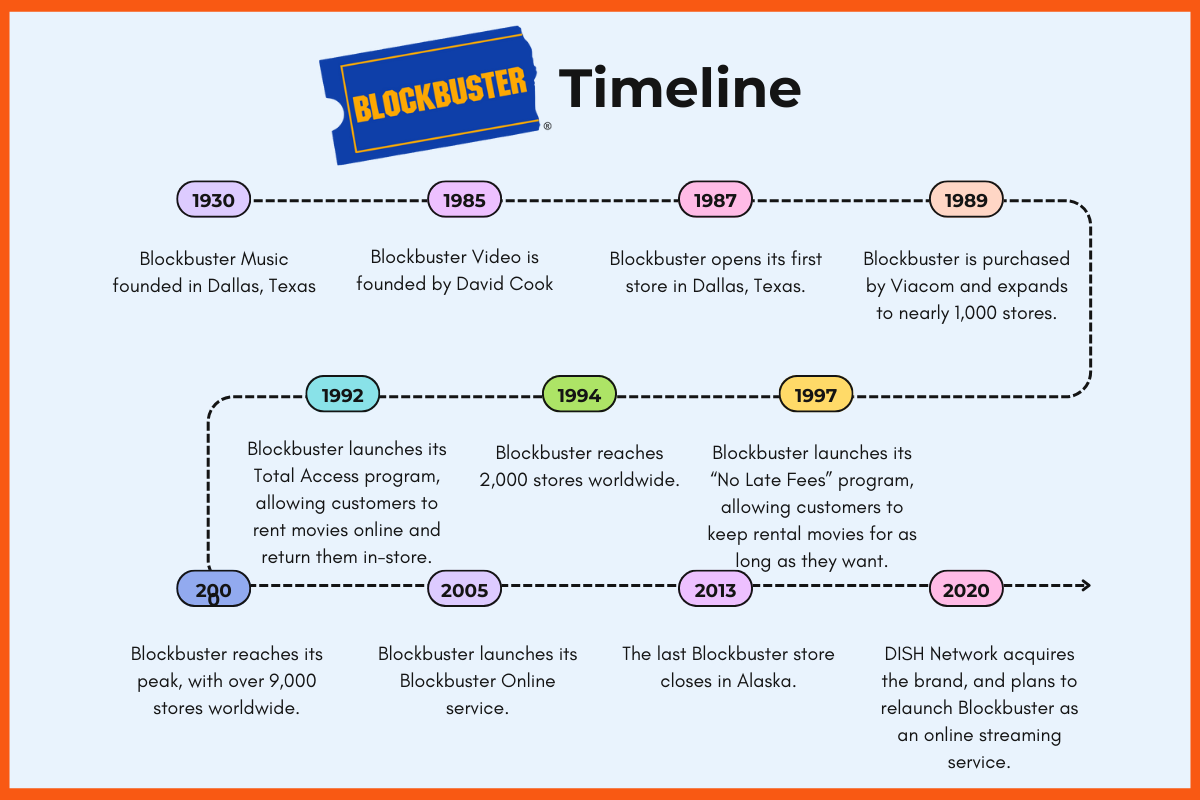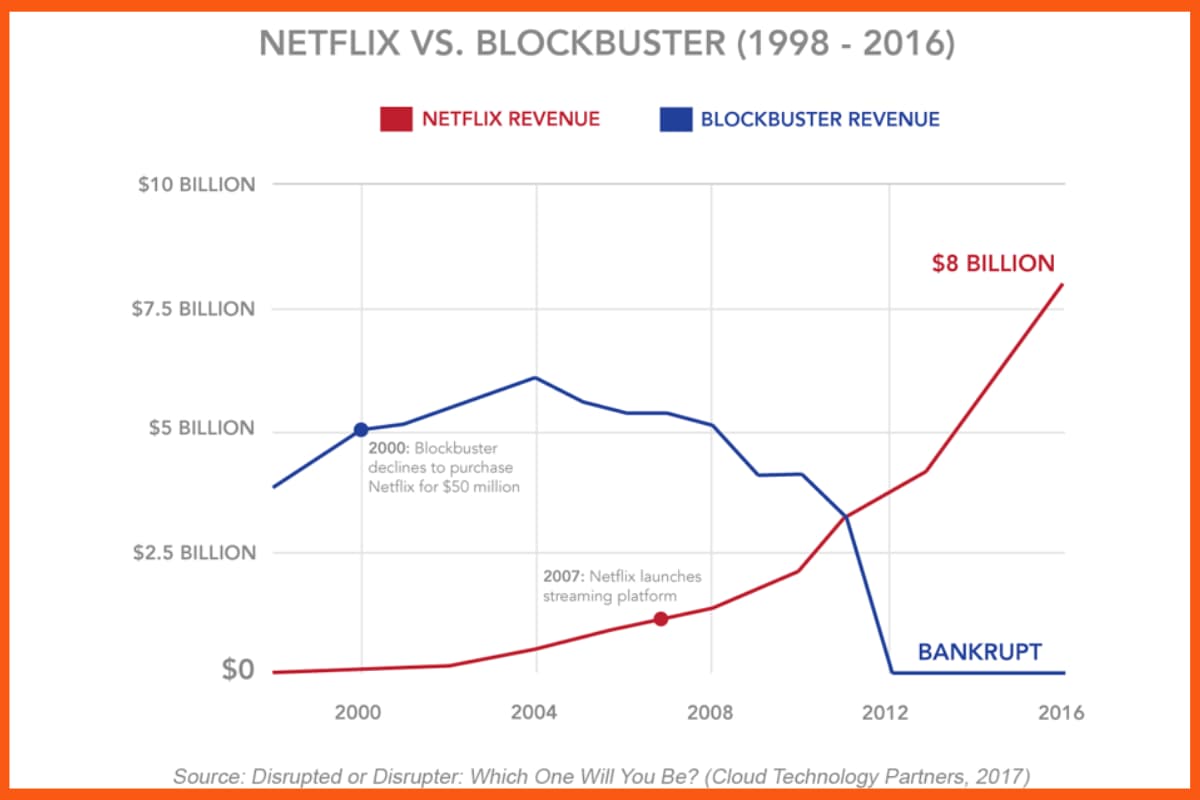Blockbuster: From Rental King to Digital Fade-Out | The Rise and Fall of Blockbuster
🔍Insights
The movie and entertainment industry is an ever-changing and ever-evolving field. New movies are being released every month, new streaming services are popping up, and new trends in the industry are emerging. It is important to stay up to date on the latest news and trends in the movie and entertainment industry to stay relevant and competitive. The rise of television began in the late 1920s and early 1930s with the invention of mechanical television. It was a primitive form of television that used a mechanical disk with a spiral pattern of holes on it to scan images. This technology was used until the 1950s when it was replaced by electronic television. This technology allowed for the transmission of images in colour and with sound. The first commercial television station began broadcasting in the United States in 1941, and by the 1950s, television had become a staple in most American households. Television programming expanded rapidly over the following decades, and by the 1990s, it had become a major source of entertainment, news, and information. Today, television is available in almost every home worldwide and continues to be an important form of media. There lies a business that runs around this sphere, a video rental business.
A video rental service is a business that rents out videos and other media, usually on a subscription basis. The service may also offer to stream video content. Video rental services typically require customers to pay a monthly subscription fee, with additional fees for rentals or purchases. The service may also offer a selection of movies and television shows available for streaming. The growth of video rental services is directly correlated to the number of television sets that are in circulation. With the increase in television sets, the demand for video rental services will increase as well, as people will have more options available to them for watching movies and TV shows. The demand for video rental services will also increase with the introduction of new technology, such as streaming services, which offer access to larger libraries of movies and TV shows. As the number of television sets in circulation increases, the demand for video rental services will likely continue to grow as well. This article is about one such business. That business is known to the world as ‘blockbuster’, a famous foreign company that dealt with video rental services. We will discuss the rise and fall of blockbusters in this article.
Blockbuster
The Rise of Blockbuster | History of Blockbuster
Blockbuster Timeline
The Fall of Blockbuster
The Reasons Behind the Fall of Blockbuster
The New Streaming Business
Blockbuster
Blockbuster was an American-based provider of home movie and video game rental services through video rental shops, DVD-by-mail, streaming, video on demand, and cinema theatres. The company was founded in 1985 and went bankrupt in 2010. At its peak in 2004, Blockbuster employed 84,300 people worldwide, including about 58,500 in the United States and about 25,800 in other countries, and had 9,094 stores in total, with more than 4,500 of these in the US. The company also had retail outlets in Canada and the UK. Blockbuster offered customers the ability to rent VHS tapes and later DVDs and Blu-ray Discs, as well as video game consoles, video games, and other related merchandise.
Customers could also purchase films or video games, as well as rent or buy previously viewed movies. In 2005, Blockbuster began rolling out its Total Access program, which allowed customers to return rentals to a Blockbuster store and receive a rental credit, as well as access to movies by mail. In 2010, Blockbuster filed for Chapter 11 bankruptcy protection. The company was acquired by Dish Network in April 2011 and was subsequently closed down in November 2013.

The Rise of Blockbuster | History of Blockbuster
Before the Internet era, video rental businesses relied on customers physically visiting the store to rent a movie or television show. Customers would typically browse the store's selection and then take the desired video to the checkout counter to pay for the rental. Many video rental stores also offered additional services such as popcorn, candy, and soda. Some businesses also provided gaming systems and game rentals. Video rental businesses also relied on word-of-mouth marketing to attract new customers. Owners would often promote new releases and special offers through flyers and newspaper ads. Additionally, video rental stores often developed relationships with local businesses, such as restaurants and coffee shops, to offer discounts and special promotions. Video stores also offered additional services, such as late fees for returns, membership discounts, and loyalty programs. These incentives helped to encourage customers to return to the store and increase their spending. The advent of the Internet has drastically changed the video rental industry. With the rise of streaming services, such as Netflix and Hulu, consumers no longer need to visit a physical store to rent a movie or television show. This shift has caused many video rental stores to close their doors.

The company was immensely popular throughout its history, particularly in the mid to late 1990s when it was the largest rental chain in the world. Blockbuster's popularity was due in part to its large selection of films, its convenient locations, and its low prices. The company also had a strong online presence, allowing customers to rent films and video games over the internet. Then came a great invention from humans, the internet. The rise of the internet led to a decline in many sectors and changed how we build relations with products and services. Thus, stores had to make a big shift and move to the internet.
The decline of brick-and-mortar businesses was primarily due to the rise of e-commerce. As online shopping has become more accessible and convenient, many customers are opting to purchase goods and services through the internet instead of going to physical stores. Additionally, brick-and-mortar stores have had to contend with rising rents and operating costs, which have made it difficult to maintain their businesses. Finally, large retail chains have been able to leverage their buying power to offer lower prices, making it difficult for smaller, independent stores to compete. The decline of brick-and-mortar video rental stores has been a result of several factors. The increasing popularity of streaming services such as Netflix, Hulu, and Amazon Prime has made it easier and more convenient for people to watch movies without leaving their homes. Additionally, the cost of renting movies has gone down significantly since the advent of digital downloads, making it a more economical option for consumers. Finally, the growth of the internet has led to more people downloading and watching movies online rather than in physical stores. All of these factors have contributed to the decrease in brick-and-mortar video rental stores.
Blockbuster Timeline
Blockbuster could have been a multi-billion-dollar business, but things changed rapidly. They did not shift to the internet medium, and they also lacked thick fur for the future. The company’s success was largely attributed to its ability to outcompete smaller rivals. It was able to offer a greater selection of titles, lower prices, and convenience to its customers. Blockbuster also invested heavily in new technologies, such as DVD and VHS players, which allowed them to offer customers the latest releases. However, Blockbuster’s success was short-lived.
We can learn a lot from the story of the rise and fall of such a business. So here we present the Blockbuster history timeline for its business.

- 1930: Blockbuster Music is founded in Dallas, Texas.
- 1985: Blockbuster Video is founded by David Cook.
- 1987: Blockbuster opens its first store in Dallas, Texas.
- 1989: Blockbuster is purchased by Viacom and expands to nearly 1,000 stores.
- 1992: Blockbuster launches its Total Access program, allowing customers to rent movies online and return them in-store.
- 1994: Blockbuster reaches 2,000 stores worldwide.
- 1997: Blockbuster launches its “No Late Fees” program, allowing customers to keep rental movies for as long as they want.
- 2000: Blockbuster reaches its peak, with over 9,000 stores worldwide.
- 2005: Blockbuster launches its Blockbuster Online service.
- 2013: The last Blockbuster store closes in Alaska.
- 2020: DISH Network acquires the brand, and plans to relaunch Blockbuster as an online streaming service.
The Fall of Blockbuster
The fall of Blockbuster began in the early 2000s with the rise of streaming services such as Netflix. The convenience of streaming services and their wide selection of new and classic films allowed customers to access the content they wanted without having to leave their homes. This quickly began to put pressure on the existing Blockbuster business model, which relied heavily on in-store rentals. The decline of Blockbuster was further accelerated by the growth of digital media, which made it easier for consumers to access content directly from their devices. This allowed customers to skip the middleman of Blockbuster, further eroding the company's revenue stream. By 2010, Blockbuster had filed for bankruptcy, marking the end of an era of physical movie and video game rental stores. The dawn of streaming had begun, and the industry has since grown exponentially. With the success of Netflix, Amazon Prime, and other streaming services, the future of streaming is only looking brighter.

The decline of video rental businesses after the internet era was a major blow to the industry. The rise of streaming services, such as Netflix and Hulu, made it easier and more affordable for people to watch movies and TV shows online. This shift in consumer behaviour caused a decrease in demand for physical video rentals and an increase in demand for digital content. As a result, many video rental businesses were forced to close their doors, unable to compete with the new digital options. Additionally, the decrease in demand for physical videos led to a decrease in the production and sale of physical copies, furthering the decline of video rental businesses.

The Reasons Behind the Fall of Blockbuster
The Rise of Blockbuster
Blockbuster began in 1985 as a revolutionary video rental business that changed how people accessed movies. Customers could rent films from their local store or even enjoy home delivery, which was a big shift from the traditional rental system. By the early 2000s, Blockbuster had become a household name in America, boasting over 9,000 stores across the country and becoming a central part of home entertainment culture.
The Internet’s Impact on Entertainment
In the early 2000s, the internet exploded in popularity with the rise of social platforms like MySpace and Friendster. This digital boom brought a wave of new websites, apps, and services that transformed how people consumed content. However, as more people got online, concerns around safety and cyberattacks also grew, leading to a brief dip in trust and usage. Despite this, the internet bounced back stronger, becoming even more essential with the arrival of cloud computing and the Internet of Things (IoT), reshaping how we interact with media.
The Fall of Blockbuster
Blockbuster’s downfall came largely due to the rise of streaming platforms such as Netflix, Hulu, and Amazon Prime. These services offered unmatched convenience and affordability, which quickly won over customers. Blockbuster failed to keep up with changing technology, sticking to its outdated model of physical DVD rentals. Its rigid return policies and late fees, once accepted by customers, became a drawback. Most critically, the company was too slow to embrace online streaming, giving its competitors the edge they needed to dominate the market.
Failure to Adapt
Blockbuster struggled to keep up with changing times. In 2000, it famously turned down the chance to buy Netflix for just $50 million—a decision that proved costly. While Netflix moved toward a smooth, fee-free streaming model, Blockbuster stuck with annoying late fees and was slow to go digital. By the time it launched its own online rental service in 2004, Netflix was already way ahead.
Financial Struggles
On top of tech troubles, Blockbuster was drowning in debt from years of rapid expansion. As people shifted to digital downloads and streaming, fewer customers were renting DVDs, and Blockbuster’s earnings took a major hit.
The Final Decline
Everything came crashing down by 2010, when Blockbuster filed for bankruptcy. Dish Network bought its remaining assets in 2011 but couldn't revive the brand. By 2013, all corporate-owned stores and the DVD-by-mail service shut down. The last company-owned Blockbuster store closed in 2014, marking the end of an era.
The Decline of Blockbuster
The New Streaming Business
With the emergence of streaming services like Netflix, Hulu, and Amazon Prime, Blockbuster lost its competitive edge. Its stores were unable to keep up with the advancing technology, and customers began to abandon the chain in favour of these new services.
When the video rental business declined because of the rise of internet services, there were many benefits that users could witness. With streaming services at our disposal, we got to see that there were many benefits. As people are moving and shifting rapidly towards the streaming movies side of entertainment. That trend, we can see, is also somehow continuing to this day. Let us see what are the benefits of streaming services.
- Cost Savings: One of the biggest advantages of streaming services is that they can save you money. With streaming services, you don't have to pay for individual downloads or CDs, or even a monthly subscription fee. Thus, saving money for the customer and increasing loyalty.
- Convenience: With streaming services, you don't have to worry about downloading or storing music or videos. Everything is accessible from the cloud, and all you need is an internet connection to access it.
- Quality: Streaming services offer high-quality sound and video, so you can enjoy the best possible experience. That is your mini theatre for your home, which is portable and easily accessible.
- Variety: Streaming services offer a wide variety of music and video content, so you can always find something new to watch or listen to.
- Accessibility: Streaming services are available on multiple devices, so you can access your content from anywhere.
- Personalisation: With streaming services, you can customise your experience and tailor it to your preferences.
- Flexibility: If you don't like a certain song or video, you can easily skip it and move on to something else.
Conclusion
Blockbuster attempted to compete with these streaming services, but it was too late. The company filed for bankruptcy in 2010, and all remaining stores closed in 2014. The Blockbuster era had come to an end. Although Blockbuster is now defunct, its legacy lives on. It paved the way for the current home video rental market, and its innovative business model provided the foundation upon which streaming services to built. So, the popular video rental chain allowed customers to rent movies and video games from physical locations.
We can say that declining physical video rental businesses can look to alternative revenue streams to stay afloat. These include offering streaming services, subscription-based video on demand, and online sales of physical media. Additionally, they should consider expanding their offerings to include more niche titles and creating special promotions and discounts to attract new customers. Finally, they should consider partnering with other local businesses to offer additional services and promotions to their customers.
FAQ
When was Blockbuster founded?
Blockbuster was founded in 1985.
What was Blockbuster's biggest mistake?
Blockbuster's biggest mistake was it did not involve the streaming company directly. In 2000, Reed Hasting flew out to meet with Antioco and proposed a partnership but Blockbuster turned it down.
Why did Blockbuster collapse?
Blockbuster driven by physical rental stores, began struggling to compete with streaming and mailing platforms. Blockbuster was driven into bankruptcy because it failed to adapt quickly enough.
What is Blockbuster Video business model?
Blockbuster's business model revolved around late fees in their movie and video game rental services. Blockbuster charged a dollar per day in late fees if a customer didn't return their movies on time. Late fees remained a hallmark memory for recurring customers and a primary source of income in the early 2000s.
What has replaced Blockbuster?
In early 2000, Netflix founders Reed Hastings and Marc Randolph offered to sell the company to Blockbuster for $50 million. Blockbuster turned them down. Eventually, Netflix triumphed over Blockbuster, popularized streaming, and forced the entertainment industry to adapt.
How long was Blockbuster in business?
Blockbuster was in business for about 29 years. It started in 1985 and peaked in the early 2000s with thousands of stores. However, due to rising competition and failure to adapt, it filed for bankruptcy in 2010. The last company-owned stores closed in 2014.
Why was Blockbuster successful?
Blockbuster was successful because it made movie rentals easy and accessible, offering a wide selection of titles in clean, well-organized stores. Its convenient locations, strong brand, and family-friendly atmosphere made it a go-to spot for home entertainment in the pre-streaming era.
How did Blockbuster work?
Blockbuster worked by letting customers rent movies or video games from local stores for a set number of days. People would browse shelves, pick a title, and pay a rental fee. Late returns came with extra charges. Rentals had to be returned to the same store.
What did Blockbuster sell?
Blockbuster mainly sold movie and video game rentals. It also sold DVDs, VHS tapes, video games, snacks like popcorn and candy, and sometimes movie-related merchandise.
What was Blockbuster?
Blockbuster was a popular video rental store chain where people could rent movies and video games. It started in 1985 and became a huge part of home entertainment before streaming services took over.
Must have tools for startups - Recommended by StartupTalky
- Convert Visitors into Leads- SeizeLead
- Website Builder SquareSpace
- Manage your business Smoothly Google Business Suite







